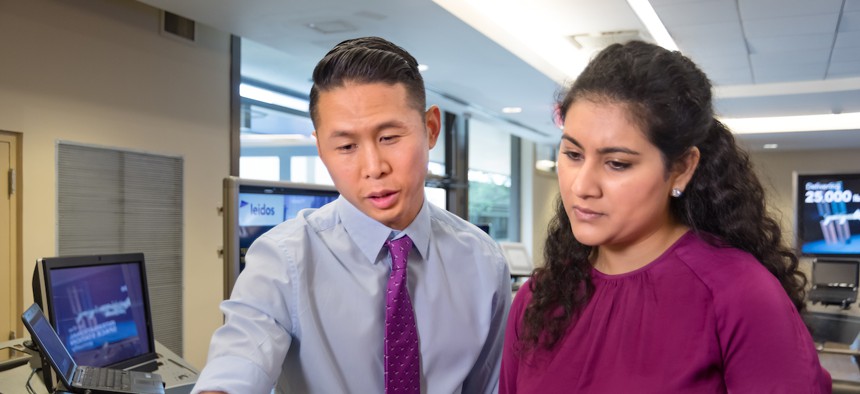The 3 Unspoken Keys to IT Modernization Success
Organizations who want improved efficiencies and lower IT costs should consider the cloud, agile at scale and mission-focused solutions
Presented by
Leidos

The 3 Unspoken Keys to IT Modernization Success
Organizations who want improved efficiencies and lower IT costs should consider the cloud, Agile at scale and mission-focused solutions
Government agencies are under increasing pressure to upgrade their information technology. Not only must they answer to government-driven IT modernization initiatives; they must also address the expectations of tech-savvy end users who are used to high-performing, mobile-friendly applications.
The pressure comes from within as well. Agencies want to take advantage of new technologies -- from software as a service to cloud solutions – to make their own systems more reliable, efficient and secure while at the same time reducing operation and maintenance (O&M) and licenses costs. Lowering these costs enables agencies to invest in improving mission-focused solutions and provide new and changed capability at mission-speed and in response to new legislation and regulations.
With so much innovative technology to choose from, it can be difficult to decide how to move forward. That said, there are three unspoken keys that determine the success of most IT modernization efforts.
1) Cloud Migration
Cloud solutions offer several benefits to government agencies. First, migrating applications to the cloud provides more reliability and efficiency, as the cloud can easily scale during times of peak performance.
The cloud is also cost-effective. There's no longer a need to purchase additional hardware to increase storage capacity – capacity and performance can be provisioned on-demand. Since applications now run on virtual machines rather than out of large data centers, operating expenses decrease as well. Agencies can quickly provision the capacity needed to match the peaks and valleys that mission operations demand.
The key to a successful cloud migration, however, is taking a holistic approach. It's vitally important to look at all application dependencies before moving an application to the cloud.
For example, many applications rely on relational databases. If a database remains on site while other applications move to the cloud, organizations may experience lower performance due to latency as well as higher communications costs through third-party telecommunications providers.
Therefore, it often makes sense to move a group of applications together, especially if they communicate a lot with each other.
Leidos has worked on many large cloud migration projects for the U.S. government, including one for the General Services Administration (GSA) called CIO Application Maintenance, Enhancement, and Operations (CAMEO).
For this project, Leidos is responsible for modernizing and migrating almost 100 GSA applications from multiple data centers and dispersed cloud platforms onto a single, secure optimized cloud. These applications, which the GSA uses for its external customers, range from client-server applications to applications running on commercial off-the-shelf (COTS) products, custom code and mainframes.
Since the contract began in 2014, Leidos has moved about half of GSA’s applications and helped the agency reduce the time it takes to onboard new applications from 32 hours to 5 minutes. Automation has also significantly lowered labor and hardware maintenance costs.
2) Agile at Scale
Many government agencies use Agile software development to spur faster release cycles through continuous development, testing, and user feedback.
Unfortunately, when several teams are involved on a project, they can become stove-piped. The result is poor communication, duplicative efforts, and a lack of standard protocols that all developers follow.
In such cases, agencies should consider implementing Agile at scale as part of their IT modernization plan. Scaling up enables them to manage across multiple Agile software development teams who work on different projects that are coordinated as part of a large program.
There are several aspects to Agile at scale that can help organizations save time and become more efficient:
- Additional governance: Create an enterprise architecture and systems engineering team to facilitate communications among multiple Agile teams, provide guidance, and ensure teams adhere to agreed-upon architectural standards.
- Development framework: Standardize on a small set of code libraries to limit complexity and reduce O&M costs.
- Automated testing: Use SecDevOps teams to automate testing and embed security protocols, thereby reducing defects in development and production.
One example of Agile at scale is the CAMEO project mentioned previously. Leidos helped the GSA move from traditional Waterfall to Agile and SecDevOps development, in which multiple teams worked on synchronized release cycles. Leidos also standardized common services, such as single sign-on and data encryption, that development teams could follow when modifying or deploying a new application.
These changes helped reduce the time it took to achieve an authority to operate from six to eight months down to two to three weeks, enabling quicker mission delivery.
3) Mission Focused, Product Agnostic
When it comes to IT modernization, another best practice is focusing on the mission first. What goals does the organization have? What problems keep its leaders up at night?
The solution comes next, and it should be tailored specifically to the needs of that mission. It should also take into account an organization's cost constraints, and the functional and performance requirements of the upgraded or new applications.
For example, relational databases have become quite expensive for government agencies that pay license fees based on a growing number of users. Leidos has helped multiple organizations in the defense, intelligence and civil markets lower their costs by migrating their data to either open source solutions or cloud-based products.
It's a more holistic approach to IT modernization, and one that focuses on the customer and the end user first.
Modernizing aging systems can be a highly complex and lengthy endeavor. But it is also transformational. Organizations who want innovative technology are seeking greater performance, improved efficiencies, and lower costs. By following the three best practices mentioned above, they'll be closer to their goal.



